Manchester United are top of the league. So how good are they?
Following their 1-0 victory against Burnley, Manchester United are top of the Premier League table, Ole Gunnar Solskjaer and his players are three points ahead of Liverpool in second, with the chance to extend that to six points in their next fixture at Anfield on Sunday.
This is a United team that’s very much in the midst of a title race. The weirdness of the Premier League in 2020-21 (think less aggressive pressing, an extremely tight top half of the table, COVID-enforced postponements and so on) paired with the quality of the current squad and the way the team are playing means they do have a genuine chance of winning a record-extending 21st title in 2021.
Solskjaer’s current team have few of the hallmarks of the late Ferguson-era sides, especially the 2012-13 team that last won the league. Although that side didn’t quite have the consistent spine that the current team does, was far older on average and featured players in Vidic, Giggs, Scholes and Ferdinand who’d been with the team for a long time. When you look at the comparison graphics below, you see though that both teams had a similar amount of players in their peak (the red column).


Another difference is how this season, United’s general ethos towards scoring away from home is built around a sluggishness at the start of games requiring record-breaking performances.
United are unbeaten on the road, but went behind in each of their victories against Brighton, Newcastle United, Everton, Southampton, West Ham and Sheffield United. Collectively, those games represent the most away wins from losing positions in a single season in Premier League history. In addition, only five teams — Everton in 2002-03, Arsenal in 1999-00 and 2011-12, United themselves in 2012-13 and Newcastle United in 2001-02 — have won more games both home and away from losing positions too.
There’s two ways to view that stat. Either this is a United side with an elite winning mentality, not taking no for an answer and hell-bent on digging deep to find the resolve to turn a loss into a win. Or it’s a team that have been capable of beating these sides from the first whistle, gone a goal behind thus making the task harder than it already is and comfortably having the firepower to overcome their opposition by full-time.
Either way, the very essence of the tactical or statistical wrinkle of United’s play will be tested on away trips to Liverpool, Arsenal, Chelsea, Manchester City, and Tottenham in the coming months, sides who have an extra level of quality and are better able to manage games if they go a goal up early in the game.
The table never tells the full picture though, and although United are the form team in the Premier League at the moment, does that indicate a side whose title challenge in 2020-21 is built on solid foundations, or is there cause for concern in the coming weeks?
Cutting to the chase, this United team’s underlying numbers are in the good-to-great category, perhaps not indicative of a team that is solid enough at both ends to realistically sustain a title challenge over the remaining 21 games of the season.
This marries up with the bookies’ implied odds, who reckon there’s a 13 per cent chance that United finish the season as champions. Manchester City are clear favourites at 53 per cent with Liverpool next in line at 23 per cent.
Seemingly, the market believes that there’s enough in City’s recent form and two games in hand to suggest that they’ll make up the seven-point gap on United. It also points to Liverpool’s recent dip being down to a bit of misfortune and not reflective of more systemic issues with Jurgen Klopp’s team that could cost them in the defence of their title.
United’s non-penalty expected goal difference of +0.28 per game places them seventh in the Premier League. That figure is marred by a slow start in the league and, although only to a small extent given 17 games have been played now, the xG racked up by Tottenham in United’s 6-1 defeat at home in their third game of the season.
Things have rebounded since then and considering just the games since the start of November onwards, United’s expected goal difference has jumped to +0.57. That’s still only good enough for fifth though, behind Liverpool, Aston Villa, Chelsea and Manchester City.
That change in fortunes is reflected in the graphic below, showing a ten-game rolling average of United’s xG for and against. Recent matches have seen the attack return back to a position where it’s as good as it’s ever been under Solskjaer.
It’s at the back where the problems lie. United are practically average defensively, irrespective of the whether you slice their defensive numbers by volume of shots, the average chance quality by xG per shot or the combination of the two in terms of xG against.
There has been some improvement in recent weeks, although part of that is due to the effect of the Tottenham game subsiding, and the trend for xG against does look to be creeping up a little bit too.
Still, United aren’t too far away from their performances at the end of last season, which this rolling trend points to as the best they’ve been defensively under Solskjaer.

The short-term goal for United then is to either increase or decrease the volume and quality of shots they take or concede respectively. The long-term goal is to simultaneously do both, widening the chasm between the number of goals scored and conceded through improving the processes that result in those numbers in the first place. Do that and you’ll win more games and help your odds of finishing top.
How to improve United from a defensive standpoint is a full article in itself, given there appears to be a ceiling to Solskjaer’s defensive performances that he hasn’t quite yet broken yet (which is, averaging less than 1 xG per game over a period of ten games, per the chart above). Attack-wise, though, there’s a lot to dig into from a statistical perspective.
United’s non-penalty xG per game of 1.37 is best for sixth in the league, although there’s a bit of an elephant in the room with United and penalties, having been awarded a Premier League record of 14 last season. That prompts an explanation of why penalties aren’t usually included in these totals.
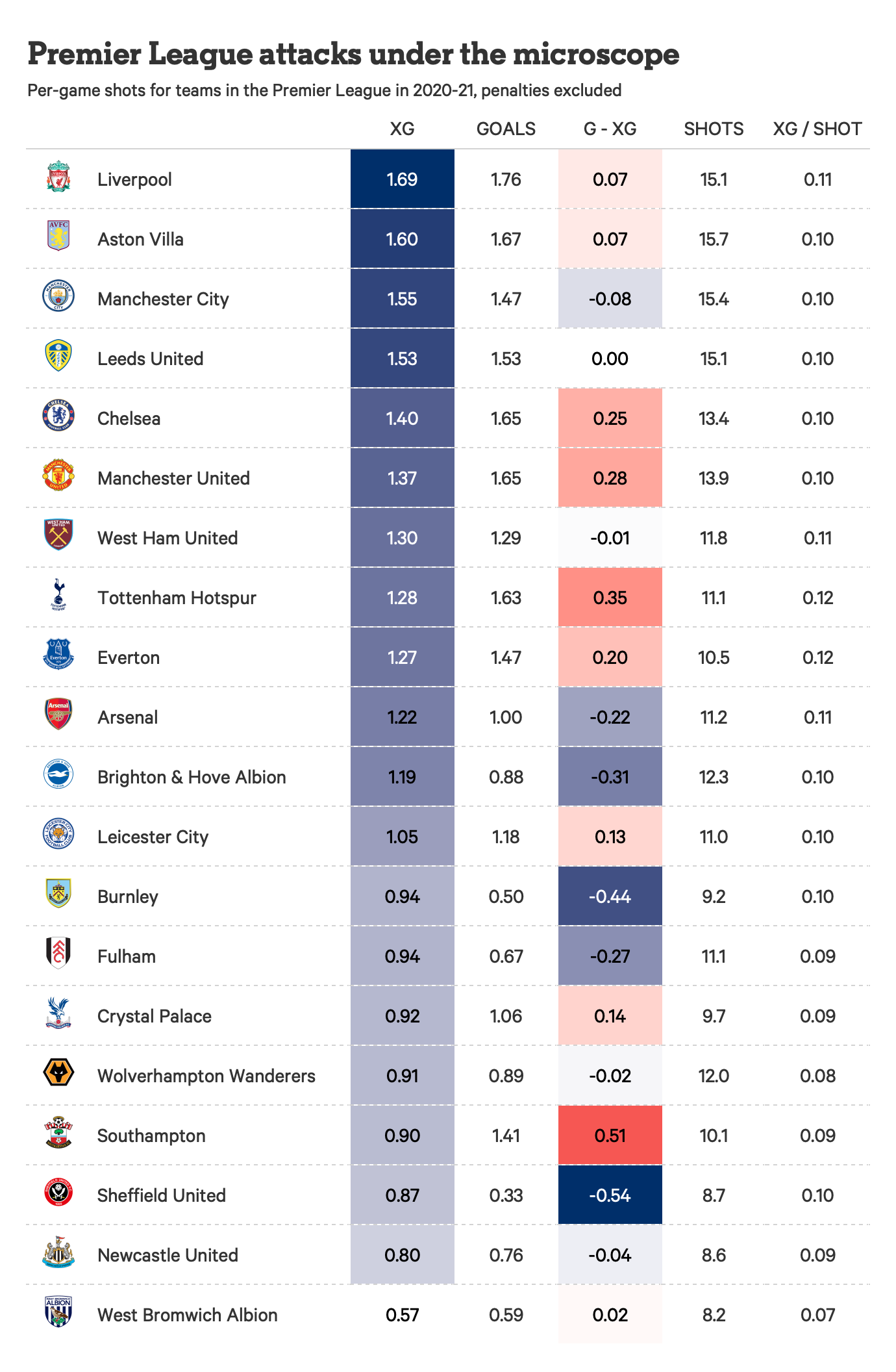
The answer? Penalties are thought to be dished out fairly randomly and there’s little evidence to suggest teams and players are particularly skilled at winning penalties season-on-season. Riyad Mahrez, for example, topped the Premier League last season with his five penalty wins, more than any other player. In the three seasons prior, he won just one. Jamie Vardy is perhaps one of the few who picks up the odd penalty consistently, averaging at least one won in his past five seasons.
Perhaps there is some merit to United’s ability to consistently win penalties as a team though and not individually — only Leicester (10) have won more penalties than United’s six this season — but that’s out of the scope of this piece for now.
The general rule though is that penalties aren’t a consistently reliable source of goals for a large swath of teams, and an ability to generate shots independent of penalties is far more indicative of a side’s goalscoring prowess in the future.
One way to improve the fortunes of the attack would be to try and better support Bruno Fernandes. There’s a huge burden on the Portuguese to both score and provide for others, alongside his extra-curricular duty as the side’s chief penalty taker. His non-penalty goal and assist tally of 0.84 per 90 is the third-highest in the Premier League, behind Diogo Jota (0.9 per 90) and Harry Kane and Heung-min Son (both with 1.13 per 90, which is quite frankly ridiculous).
Splitting Fernandes’s underlying numbers into their respective parts, it’s obvious that he is more of a chance creator (0.37 expected assists per 90) than he is a pure shooter (0.24 non-penalty xG), albeit so far this season he’s performing better than expected.
His shot map shows a Jekyll-and-Hyde-type shooter, partly prone to pretty speculative efforts from outside of the area, partly prone to getting into good positions in the box.
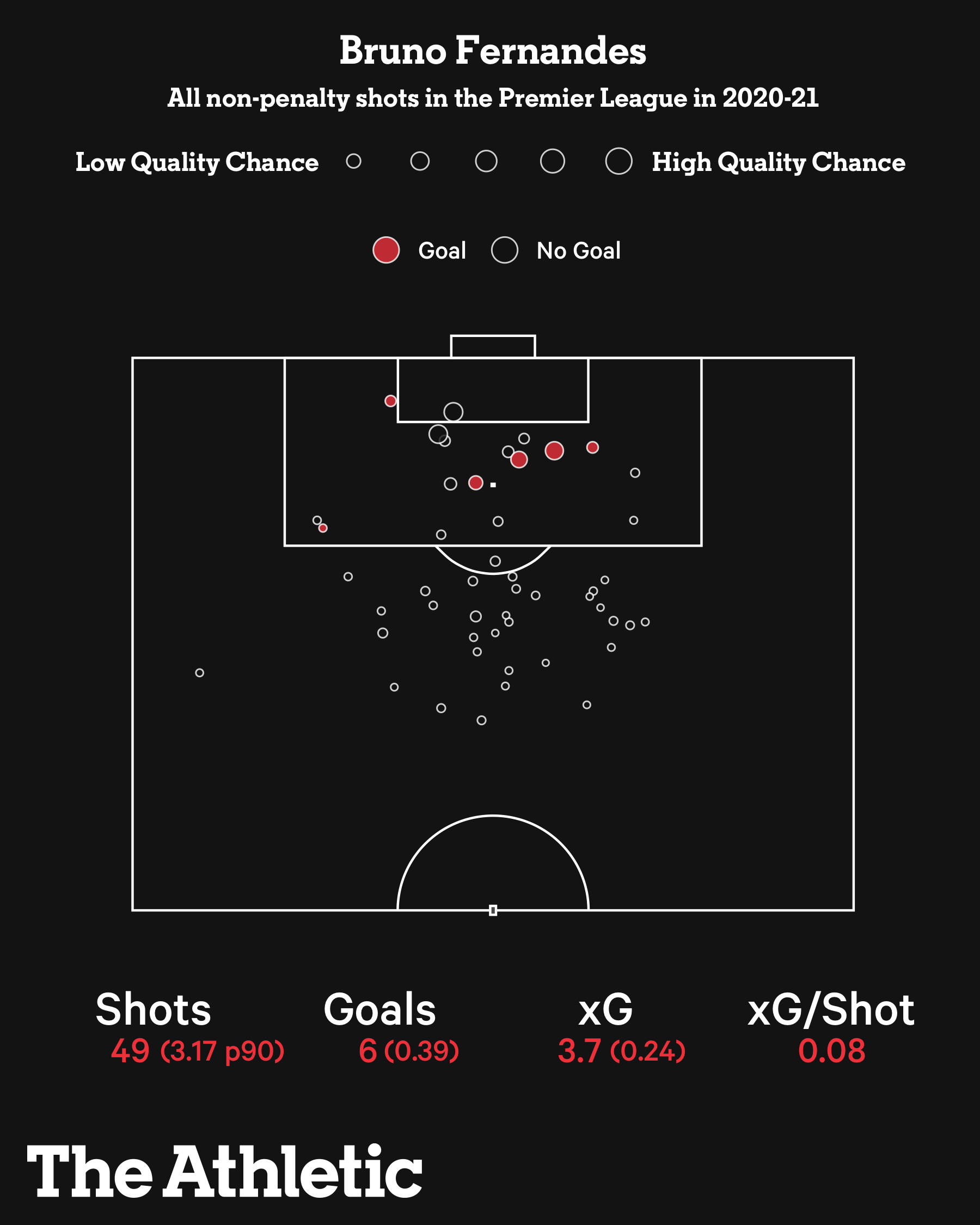
It’s in his usage numbers where he really sticks out. Considering a player’s usage rate is the share of the team’s sequences that are ended through either a shot, failed pass or take-on, being dispossessed or mis-controlling the ball, the table below shows Fernandes as, by some margin, the most high-usage player in the league.

Everything positive that United try to do runs through Fernandes. The first thought in his head at all times seems to be “go forward”, resulting in plenty of attempted passes which are difficult to execute but highly threatening if pulled off.
The solution to getting more from United’s attack and making Fernandes’s life a little less stressful could in fact lie with Marcus Rashford, not Anthony Martial.
Yes, you read that right, Rashford. It’s tempting to point to Anthony Martial as the source of United’s frustrations in front of goal, arguably with him not doing enough as the focal point of United’s 4-2-3-1. That narrative is helped by the fact he’s undershot his xG by nearly 50 per cent so far this season.
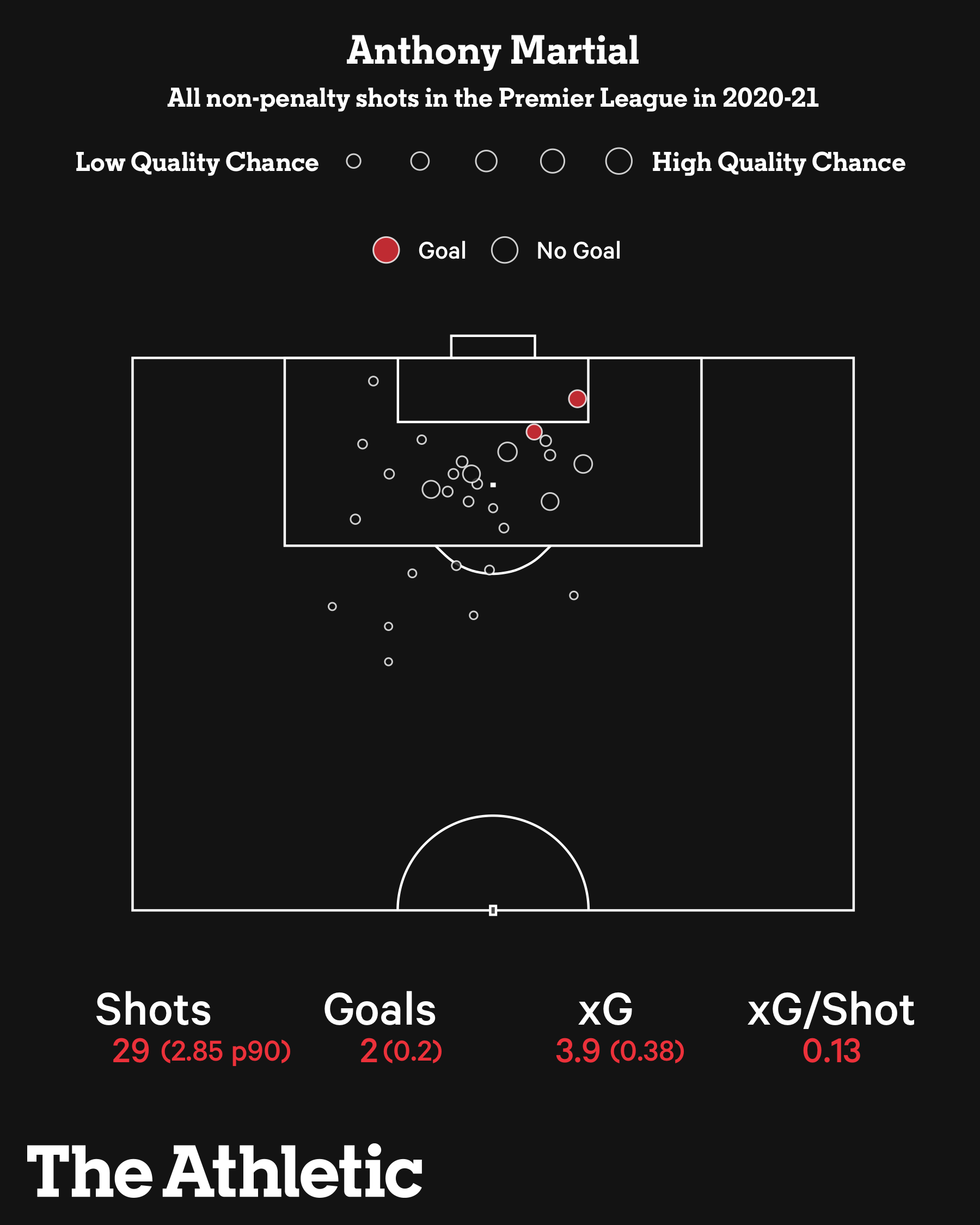
In reality, Martial is putting up similar underlying shooting numbers to last season: his non-penalty xG per 90 last season was 0.39, this season it’s 0.38. Poor finishing has cost him this season, but he’s not stopped getting himself chances.
Rashford, on the other hand, is outscoring his expected goals for only the second season of his career, while simultaneously seeing his non-penalty xG drop from 0.44 per 90 to 0.35, and expected assists similarly regress from 0.17 per 90 to 0.07. Combined, those are his lowest combined “underlying” numbers since he first broke through and played significant minutes in 2016-17.
What’s notable from his shot map below is something of a dearth of the longer-range efforts we’ve come to expect from him and, at the same time, a near-absence of efforts in the six yard-box. Rashford has trimmed out the empty calories, but has failed to replenish himself with those attempts rich in vitamin xG.
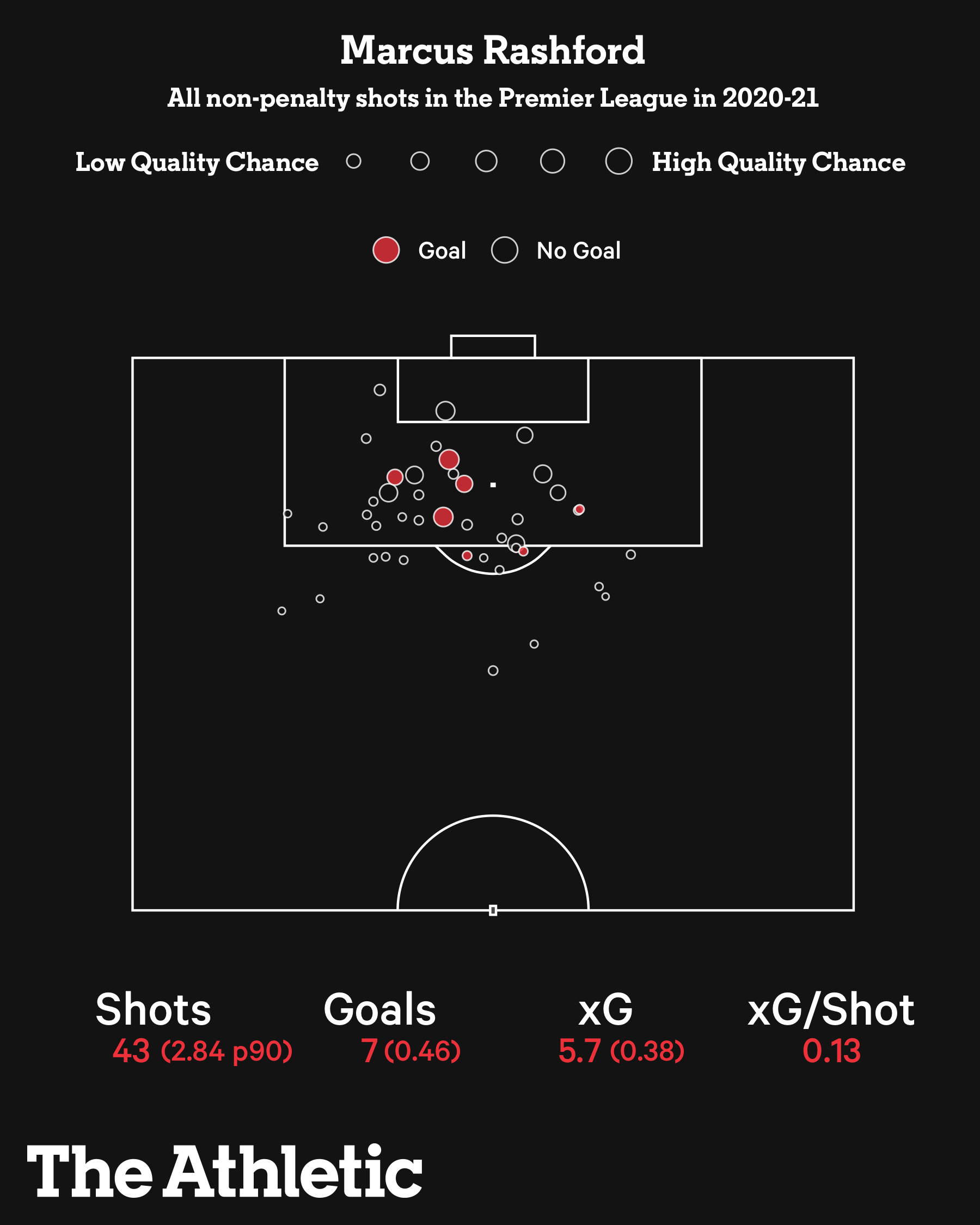
That combination is one to keep in mind over the coming weeks of the season, making Rashford one of the high-profile candidates for the “most likely to regress at some point” award.
Back to Martial, the argument could be made that he shouldn’t merely be carrying on last season’s form but improving upon it. Edinson Cavani, albeit in limited minutes, has shown that it’s possible to get high-quality chances in the box with this team.

The solution to Martial getting more chances though is reliant on more creativity across the pitch. Aaron Wan-Bissaka is improving in that regard, assisting Martial’s last goal for the side, but given the leverage Rashford has on the attacking performance of this team, it’s probably on him to bring more to the table.
The other worry with United is that, if Bruno is missing through injury, suspension or just through the need to rest, who is the creative burden going to fall to? Donny van de Beek, like Cavani, has seen limited minutes this season in the league and it’s evident he’s not a like-for-like option as United’s No 10.
While he has been stationed further back, Paul Pogba has seen his form improve a lot in recent weeks, so could be the remedy should that situation arise. He has had a good run back in the United side since the start of December, reflected in some of his key attacking and passing metrics.
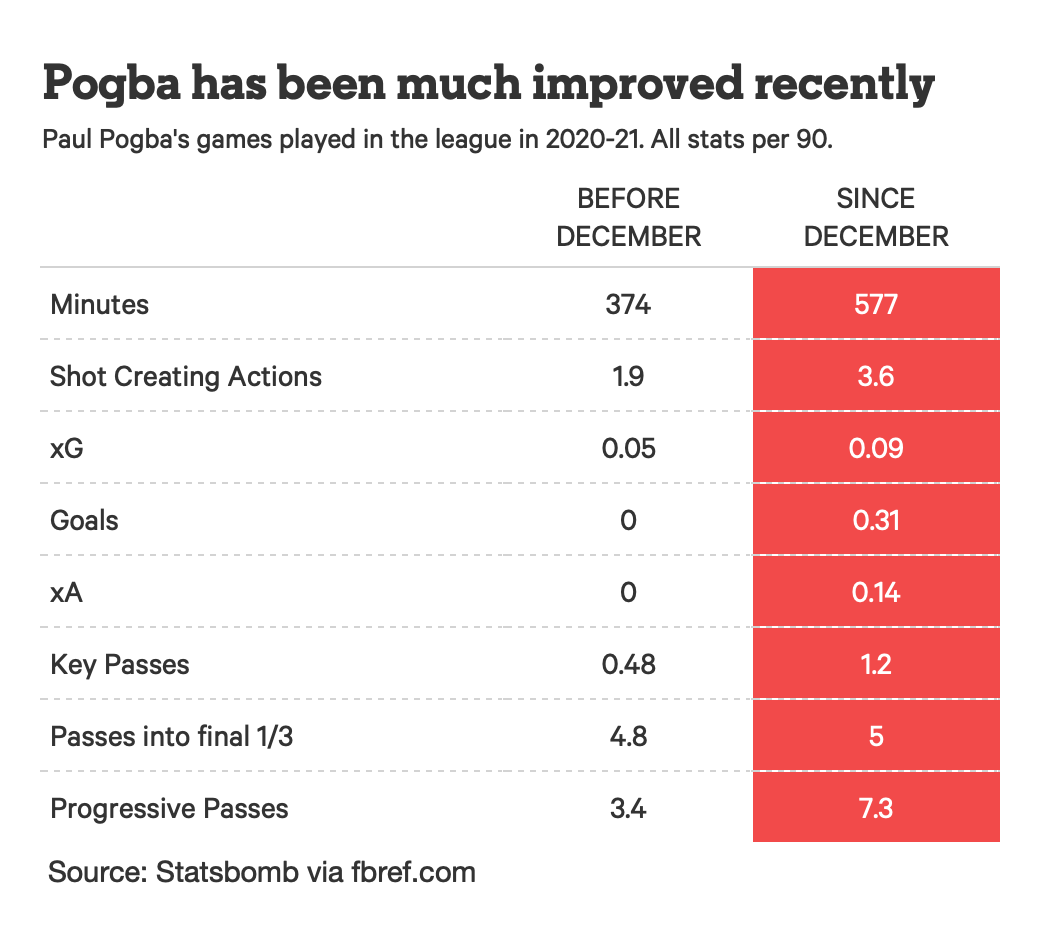
His numbers are up across the board, with Pogba being more of a goal threat (per xG, goals) more creative (xA, key passes and shot creation actions) and more progressive with his passing too (passes into the final third and progressive passes — those moving the play forward 10 metres or getting the ball into the area).
Part of this can be explained by a couple of his recent games seeing him positioned further forward than before, but Pogba has also featured in a midfield pivot alongside Nemanja Matic against Burnley, Wolves and Sheffield United of late too.
While neither the bookies nor United’s underlying numbers point to a side that are favourites for the title, they are a team with a highly functioning attack and a league-average defence.
That’s a good platform to build on from, especially considering they have the fourth-youngest squad by weighted average age (age x share minutes played) in the league, rising to second when you take out the goalkeepers, and are probably a few key pieces away from a very competent stable of players.
Ole is indeed at the wheel, but by all accounts, it’s of a mid-range sports car that takes a while to get going rather than a Ferrari or Lamborghini.
Perhaps United will get title No 21 in 2021, perhaps they won’t. This is definitely their window of opportunity to challenge though, which in itself can be deemed as progress.

 71
71 